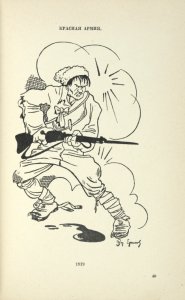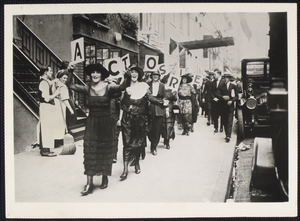As part of our 400 Years of Immigration History campaign on Twitter, we're sharing a time-line of American immigration from the very beginning to today. Tomorrow's tweet is about the1919 Palmer raids. This historical event is named after Attorney General Alexander Mitchell Palmer, who orchestrated the arrests.
During World War I, immigrants living in the United States often had conflicted loyalties. Most newcomers were thankful to be here, but many still had ties to their homelands, some of which were now enemies of the United States. Simultaneously, the threat of violence against the U.S. government was hitting close to home. In the summer of 1919, a series of bombings occurred in cities all over the country, including Washington DC, with one bomb hitting Palmer’s home. Although it was never determined exactly who was behind the bombings, Communist radicals became the primary suspect. The Palmer raids were on the cusp of what would later be termed the “Red Scare.”
On November 7, 1919 (the date specifically picked because it was the second anniversary of the Russian Revolution), the raids and arrests began. The homes and headquarters of suspected radicals were invaded, with over 10,000 arrests made. Of that incredible number, 245 were deported, including Lower East Side resident Emma Goldman and Alexander Berkman, editor of the anarchist journal Blast. The couple was sent back to Russia. [Read more.]
So what exactly were the criteria for being arrested and possibly deported? One source (PDF) wrote that “everything from parliamentary socialism to Bolshevism, encompassing ‘radical feminism,’ anarchism, and labor militancy as well” was enough cause for investigation.
Throughout American history there have times of great anxiety around immigrants similar to the Palmer

A 1919 depiction of the "Red Army"
Courtesy of the NYPL Digitalraids and the Red Scare era. For example, about 120,000 Japanese-Americans living on the West Coast during World War II were forced to live in internment camps. It was never proven that any of those incarcerated had in fact committed any kind of espionage or sabotage against the United States (about half were, in fact, children). So what was the reason for this forced segregation? According to the Commission on Wartime Relocation and Internment of Civilians, the interment camps “were motivated largely by racial prejudice, wartime hysteria, and a failure of political leadership.”
Even as recently as the past decade, some of the nation's immigrants have experienced racial prejudice. After the terrorists attacks of September 11, 2001 many Muslim-Americans feared both federal censure and random acts of violence. Some worry that racial profiling has become too common, with stricter airline rules and the Patriot Act allowing the wiretapping of suspects and the detainment of aliens deemed as “threats to national security.” It's interesting that, in fact, this same sort of profiling and surveillance took place almost 100 years ago.
I wonder how people feel about the treatment of immigrants in such tumultuous times. Do you think it's wrong to detain someone without access to a fair trial by their peers? Do you think immigrants still have strong, nationalistic ties to their homelands? How do you think that affects their allegiance to the United States? If you're interested in these questions, in addition to discussing them with friends, family, and here on the blog, pick up a copy of David Laskin's The Long Way Home: An American Journey from Ellis Island to the Great War, which chronicles 12 young men, all immigrants, who fought for the US in World War I. It's an eye-opening look at these very issues of nationhood and allegiance during war time.
- Post by Devin.


No comments:
Post a Comment
Note: Only a member of this blog may post a comment.